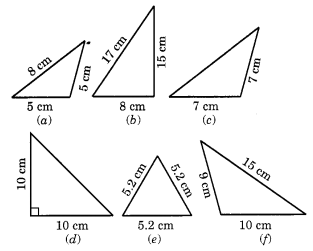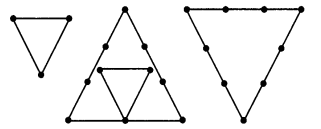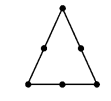Solutions For All Chapters Maths Class 6
Ex 5.6 Class 6 Maths Question 1.
Name the types of following triangles:
(а) Triangle with lengths of sides 7 cm, 8 cm and 9 cm.
(b) ∆ABC with AB = 8.7 cm, AC = 7 cm and BC = 6 cm.
(c) ∆PQR such that PQ = QR = PR = 5 cm.
(d) ∆DEF with m∠D = 90°
(e) ∆XYZ with m∠Y = 90° and XY = YZ.
(f) ∆LMN with m∠L = 30° m∠M = 70° and m∠N = 80°.
Solution:
(a) Lengths of the sides of a triangle are given as: 7 cm, 8 cm and 9 cm.
Since, all sides of the given triangle are different.
Hence, it is a Scalene triangle.
(b) Given that: AB = 8.7 cm, AC = 7 cm and BC = 6 cm
Here AB ≠ AC ≠ BC Hence, ∆ABC is Scalene triangle.
(c) Given that: PQ = QR = PR = 5 cm
Since all sides are equal.
Hence, it is an equilateral triangle.
(d) Given that: In ∆DEF, m∠D = 90°
Hence it is a right angled triangle.
(e) Given that: In ∆XYZ, m∠Y = 90° and XY = YZ
Hence it is a right angled triangle.
(f) Given that: ∆LMN, m∠L = 30°, m ∠M = 70° and m∠N = 80°.
Hence it is an acute angled triangle.
Ex 5.6 Class 6 Maths Question 2.
Match the following:
Measure of triangle Type of triangle
(i) 3 sides of equal length (a) Scalene
(ii) 2 sides of equal length (b) Isosceles right angled
(iii) All sides are of different length (c) Obtuse angled
(iv) 3 acute angles (d) Right angled
(v) 1 right angle (e) Equilateral
(vi) 1 obtuse angle (f) Acute angled
(vii) 1 right angle with two sides of equal length (g) Isosceles
Solution:
(i) ↔ (e)
(ii) ↔ (g)
(iii) ↔ (a)
(iv) ↔ (f)
(v) ↔ (d)
(vi) ↔ (c)
(vii) ↔ (b)
Ex 5.6 Class 6 Maths Question 3.
Name each of the following triangles in two different ways: (You may judge the nature of the angle by observation)
Solution:
(a) (i) Acute angled triangle
(ii) Isosceles triangle
(b) (i) Right angled triangle
(ii) Scalene triangle
(c) (i) Obtuse angled triangle
(ii) Isosceles triangle
(d) (i) Right angled triangle
(ii) Isosceles triangle
(e) (i) Acute angled triangle
(ii) Equilateral triangle
(f) (i) Obtuse angled triangle
(ii) Scalene triangle.
Ex 5.6 Class 6 Maths Question 4.
Try to construct triangles using matchsticks. Some are shown here. Can you make a triangle with
(a) 3 matchsticks?
(b) 4 matchsticks?
(c) 5 matchsticks?
(d) 6 matchsticks?
(Remember you have to use all the available matchsticks in each case)
Name the type of triangle in each case.
If you cannot make a triangle, give of reasons for it.
Solution:
(a) Yes, we can make an equilateral triangle with 3 matchsticks.
(b) No, we cannot make a triangle with 4 matchsticks.
(c) Yes, we can make an isosceles triangle with five matchsticks.
(d) Yes, we can make an equilateral triangle with 6 matchsticks.





Leave a Reply